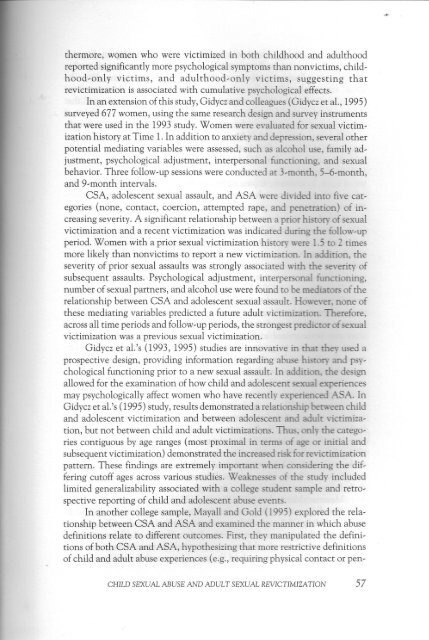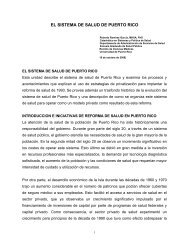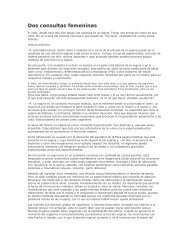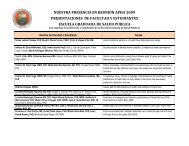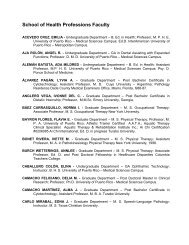CHILD SEXUAL ABUSE AND ADULT SEXUAL REVICTIMIZATION
CHILD SEXUAL ABUSE AND ADULT SEXUAL REVICTIMIZATION
CHILD SEXUAL ABUSE AND ADULT SEXUAL REVICTIMIZATION
You also want an ePaper? Increase the reach of your titles
YUMPU automatically turns print PDFs into web optimized ePapers that Google loves.
thermore, women who were victimized in both childhood and adulthood<br />
reported significantly more psychologicalsymptoms than nonvictims, child~<br />
hood~only victims, and adulthood~only victims, suggesting that<br />
revictimization is associated with cumulative psychological effects.<br />
In an extension of this study,Gidyczand colleagues(Gidyczet a1.,1995)<br />
surveyed 677 women, using the same research design and survey instruments<br />
that were used in the 1993 study. Women were evaluated for sexual victim~<br />
ization history at Time 1.In addition to anxiety and depression, several other<br />
potential mediating variables were assessed,such as alcohol use, family ad~<br />
justment, psychological adjustment, interpersonal functioning, and sexual<br />
behavior. Three follow~upsessionswere conducted at 3~month, 5-6~month,<br />
and 9~month intervals.<br />
CSA, adolescent sexual assault, and ASA were divided into five cat~<br />
egories (none, contact, coercion, attempted rape, and penetration) of in~<br />
creasing severity. A significant relationship between a prior histOryof sexual<br />
victimization and a recent victimization was indicated during the follow~up<br />
period. Women with a prior sexual victimization history were 1.5 to 2 times<br />
more likely than nonvictims to report a new victimization. In addition, the<br />
severity of prior sexual assaults was strongly associated with the severity of<br />
subsequent assaults. Psychological adjustment, interpersonal functioning,<br />
number of sexual partners, and alcohol use were found to be mediatOrsof the<br />
relationship between CSA and adolescent sexual assault. Howe'-er. none of<br />
these mediating variables predicted a future adult victimization. Therefore,<br />
acrossall time periods and follow~upperiods, the strongest predictOrof sexual<br />
victimization was a previous sexual victimization.<br />
Gidycz et a1.'s(1993, 1995) studies are innovative in that the'- used a<br />
prospective design, providing information regarding abuse histOlTand psy~<br />
chological functioning prior to a new sexual assault. In addition. the design<br />
allowed for the examination of how child and adolescent sexual experiences<br />
may psychologically affect women who have recently experienced ASA. In<br />
Gidyczet a1.'s(1995) study,resultsdemonstrated a relationship betWeenchild<br />
and adolescent victimization and between adolescent and adult victimiza~<br />
tion, but not between child and adult victimizations. Thus. onlv the catego~<br />
ries contiguous by age ranges (most proximal in tenns of age or initial and<br />
subsequent victimization) demonstrated the increased riskfor revictimization<br />
pattern. These findings are extremely important when considering the dif~<br />
fering cutoff ages across various studies. Weaknesses of the study included<br />
limited generalizability associated with a college student sample and retro~<br />
spective reporting of child and adolescent abuse events.<br />
In another college sample, Mayall and Gold (1995) explored the rela~<br />
tionship between CSA and ASA and examined the manner in which abuse<br />
definitions relate to different outcomes. First, they manipulated the defini~<br />
tions of both CSA and ASA, hypothesizing that more restrictive definitions<br />
of child and adult abuse experiences (e.g., requiring physical contact or pen~<br />
<strong>CHILD</strong> <strong>SEXUAL</strong> <strong>ABUSE</strong> <strong>AND</strong> <strong>ADULT</strong> <strong>SEXUAL</strong> <strong>REVICTIMIZATION</strong> 57


